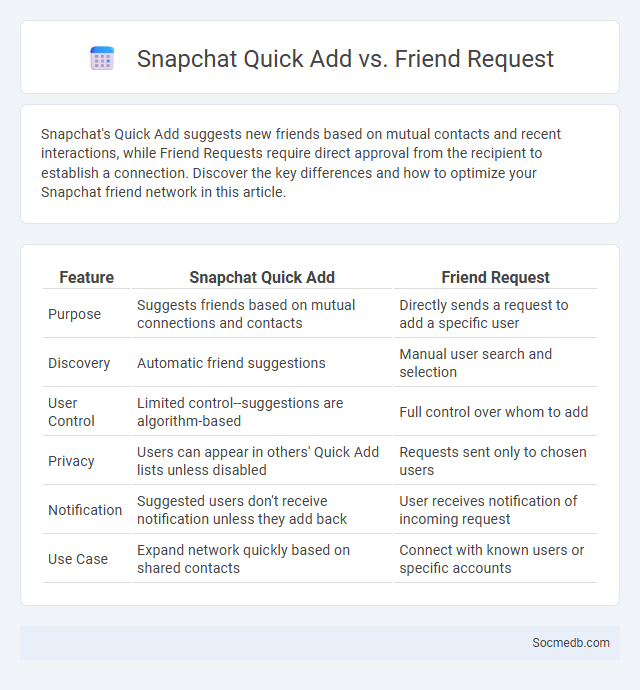
Photo illustration: Snapchat Quick Add vs Friend Request
Snapchat's Quick Add suggests new friends based on mutual contacts and recent interactions, while Friend Requests require direct approval from the recipient to establish a connection. Discover the key differences and how to optimize your Snapchat friend network in this article.
Table of Comparison
| Feature | Snapchat Quick Add | Friend Request |
|---|---|---|
| Purpose | Suggests friends based on mutual connections and contacts | Directly sends a request to add a specific user |
| Discovery | Automatic friend suggestions | Manual user search and selection |
| User Control | Limited control--suggestions are algorithm-based | Full control over whom to add |
| Privacy | Users can appear in others' Quick Add lists unless disabled | Requests sent only to chosen users |
| Notification | Suggested users don't receive notification unless they add back | User receives notification of incoming request |
| Use Case | Expand network quickly based on shared contacts | Connect with known users or specific accounts |
Understanding Snapchat Quick Add
Snapchat Quick Add uses mutual friends, contacts, and shared groups to suggest potential connections, enhancing user engagement through personalized friend recommendations. Leveraging algorithmic analysis of interaction patterns and location data, Quick Add aims to expand social circles efficiently. Optimizing Snapchat networks via Quick Add increases content visibility and fosters community growth.
What is a Friend Request on Snapchat?
A friend request on Snapchat is an invitation sent from one user to another to connect and share snaps or chats privately. When you receive a friend request, you can choose to accept or decline it, allowing you to control who interacts with your content. Snapchat uses friend requests to help secure your account and personalize your social media experience by connecting you with friends, family, or acquaintances.
How Does Quick Add Work?
Quick Add on social media platforms leverages algorithms to analyze your existing connections, interests, and mutual friends, suggesting relevant profiles you might want to follow or connect with. This feature uses data such as your location, recent contacts, and engagement patterns to provide personalized recommendations tailored to enhance your networking experience. By tapping into these insights, Quick Add helps you grow your social circle efficiently, ensuring Your feed stays dynamic and relevant.
Quick Add vs Friend Request: Key Differences
Quick Add on social media platforms suggests users based on mutual friends, interests, or contacts, enabling faster connection without a formal friend request process. Friend Request requires explicit approval from the recipient before establishing a connection, providing more control over who joins the user's network. Quick Add enhances algorithm-driven networking efficiency, while Friend Request emphasizes user consent and privacy management.
Who Appears in Your Snapchat Quick Add?
Snapchat Quick Add suggests people you may know based on mutual friends, contacts saved on your phone, and interactions within the app, such as group chats or shared Snap Map locations. The algorithm prioritizes users with close connections to your existing network to make adding new friends more relevant and personalized. Your friends' friends, contacts synced to your device, and recent interactions influence who appears in your Quick Add list.
Privacy Concerns: Quick Add vs Friend Request
Quick Add features on social media platforms often raise significant privacy concerns by suggesting connections based on mutual friends or contacts without explicit consent. Unlike traditional friend requests, which require your approval before establishing a connection, Quick Add may expose your profile to a broader audience, increasing the risk of unauthorized access to personal information. You should regularly review privacy settings to control who can discover your profile through these automated recommendations.
How to Manage Quick Add Suggestions
Quick Add Suggestions on social media platforms streamline the process of connecting with friends by recommending contacts based on mutual connections, interests, and interactions. Your privacy settings play a crucial role in controlling who appears in these suggestions, so regularly reviewing and adjusting them can help manage your visibility. To maintain your preferred network, you can customize or disable Quick Add features in your account settings, ensuring that the suggestions align with your social preferences and online security.
Accepting vs Sending Friend Requests
Accepting friend requests on social media enhances user connectivity by expanding personal networks and increasing profile visibility, while sending friend requests initiates new social interactions and potential engagement opportunities. Users strategically accept requests to maintain privacy and curate their online presence, whereas sending requests targets relationship building with friends, colleagues, or interest groups. Platforms like Facebook and LinkedIn track these actions to optimize content delivery and recommend connections based on mutual contacts and shared interests.
Pros and Cons of Using Quick Add
Quick Add on social media platforms streamlines the process of connecting with new users by suggesting friends based on mutual connections, enhancing network growth and engagement. However, it may compromise user privacy by exposing profile information to unintended contacts and facilitating unsolicited friend requests. Balancing ease of use with privacy control is essential for optimizing the benefits of Quick Add features.
Tips to Control Who Can Add You on Snapchat
Adjust your Snapchat privacy settings by navigating to "Who Can..." and selecting "Contact Me" to limit who can add you, choosing between "Everyone" or "My Friends" for tighter control. Use the "Quick Add" feature sparingly by disabling it in your settings to prevent unknown users from suggesting you as a friend. Regularly review your friend list and block or report any suspicious accounts to maintain a secure and private Snapchat experience.
 socmedb.com
socmedb.com